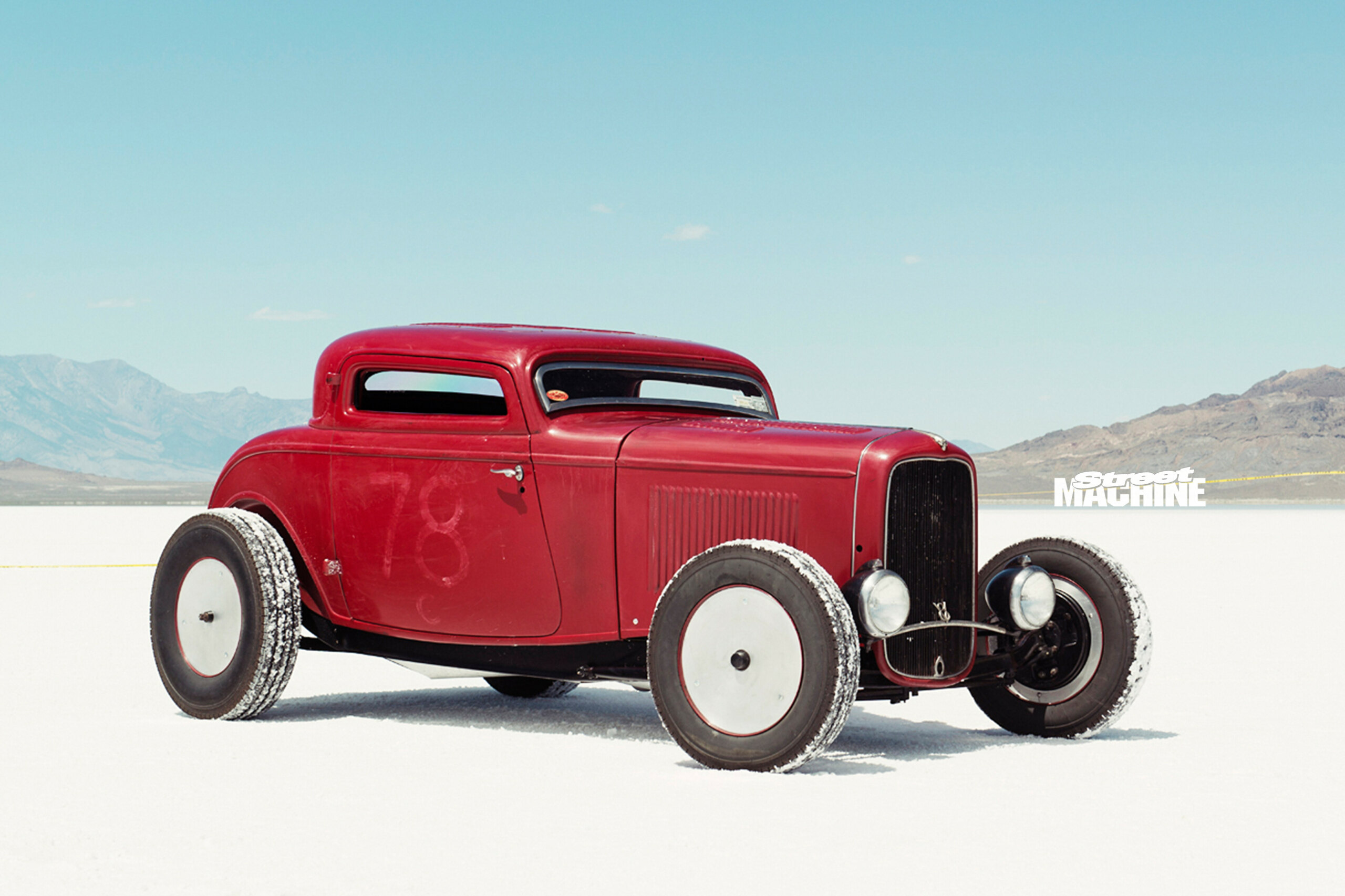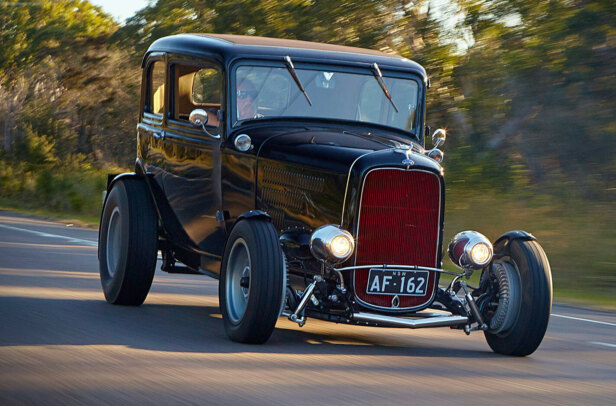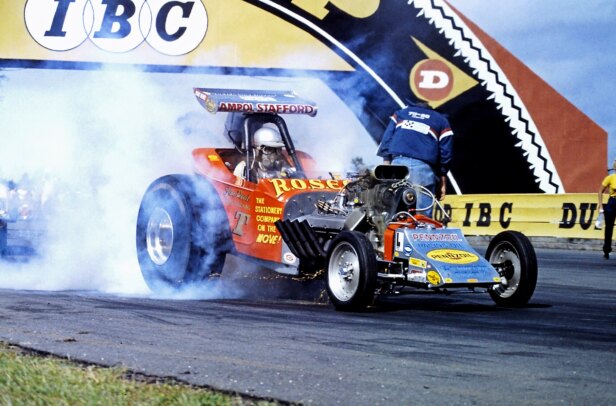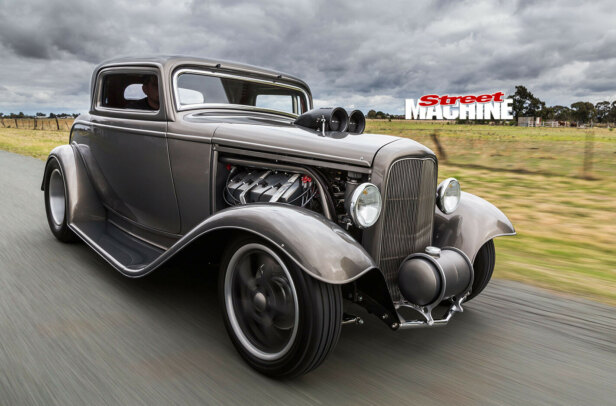Tom McIntyre is a pretty fascinating bloke. He’s a pretty unassuming kind of guy, of the older generation — which means he was actually there when drag racing and muscle cars were exploding in Southern California during the 60s — and has spent most of his life drag racing and road racing. But this was the first time he’d been to the salt lake racing at Bonneville. “I have never been here before and I’m really fascinated by it,” he says. “I was born and raised in LA, and the Mecca was here. All of Southern California came here to race and it was very important.
First published in Street Machine’s Hot Rod 12 magazine, 2013
Two of my cars raced here and one of them set a record [more on that later], so it’s a part of my life too, but I had never come here because my interest in drag racing and road racing all could be accomplished within 10 miles of home. There was a proliferation of race tracks in Los Angeles so you didn’t really have to go so far.”
You could almost argue that Tom had no chance of escaping the clutches of the drag racing bug. If there was a hot bed of drag racing and a dream team of people who you would want to know from the golden years of the sport, then Tom fell right into it. Tom had been earning a little bit of money mowing lawns and sweeping floors and it got to the point where he had saved a few hundred dollars.
“My mom asked me one time, ‘What are you going to do with all your money?’ I said, ‘Oh, that’s easy. I’m going to buy a car!’ She said, ‘Oh, isn’t that cute.’ Five years later when I was 14 I had saved up $300 and was walking around the neighbourhood and I found a Model A Ford for sale that had a price tag on it for $300. I went home and got my $300 and I gave it to the man and the man gave me the car.”
You can just imagine his mother’s reaction, but Tom was dead-set on fixing up the car, and this is where it gets really interesting. I know I just about fell off my chair when he told me this little snippet of his personal history. “We took it to a little body shop in Van Nuys and there were four shops in that little complex.
The back corner was the body shop where I took the car. Now I needed more money, so I went around to the shop owners and asked if I could sweep their floors. On the way home from school I went straight to the shop and started helping and working on the car a little bit.
“One of them was an engine builder and one of them was a chassis builder and one of them was an upholsterer, so we got to be friends and I was ‘the kid’. The engine builder was Ed Pink, the chassis builder was Kent Fuller and the upholsterer was Tony Nancy.
So Saturday nights came around and I hopped into the back of the truck with one or the other and rode down to Lions drag strip and became a drag race fan and travelling with the top teams. Ed Pink was campaigning The Old Master at the time.”
We mentioned earlier in the story that Tom had a couple of cars that had raced at Bonneville, and we’re not talking a couple of old jalopies either. “I ended up with a 1952 Bonneville streamliner, a totally unrestored racing roadster that came to Bonneville in 1954 and stood the world on its ear with a huge record; the Williams Brothers roadster. It is totally unrestored, I couldn’t touch it. Every nut, bolt and screw, nothing has been touched since it set that record.”
All up, Tom has about 30 cars in his collection, which is every car he ever owned except for three — yes, he does still own that Model A — and the collection is wide and varied and very, very desirable. How about ’64 Galaxie with a 427 and four-speed, the Penske-Hilton Sunoco ’68 Camaro that Mark Donohue won the Trans-Am championship in, the ’63 Z06 Corvette that was owned by Mickey Thompson and driven by Junior Johnson, and, of course, a ’66 AC Cobra with a 427. “They thought I was a fool for paying $7000 for it. It wasn’t very long before somebody paid $8500 and I was out of the hot seat,” Tom laughs. “It’s not like I’m a real wealthy guy that went out and bought all these high-priced cars; that wasn’t the case. I bought all these high-priced cars because my real intense interest and passion for automobiles led me to all these different shapes and tastes.”
The story behind the Corvette is amazing too. “I didn’t know it was a Z06,” says Tom. “All I knew was that it was a ’63 Stingray. So I fixed it up and took it to the Monterey races and pretty soon all the Corvette guys were knocking on my door, saying, ‘Tell us more about this car.’ I didn’t know anything about the car, so they asked if they could have a look at the chassis number and I told them the car didn’t have a chassis number!”
The Corvette guys knew something was up and wanted to have a closer look. As they suspected, it was an old racing car. “They unbolted the body and found the chassis number and discovered it was the third one built that had been missing for 20 years,” Tom reveals. “These cars were all hand-built by Zora Duntov. Smokey Yunick installed an experimental Chevrolet 427 V8 five years before it was available to the public.”
Tom has so many stories like this to share we could just about write a book about it – in fact, maybe someone should – but we better get talking about his latest addition, his ’32 three-window coupe that he’d just picked up and was driving back to California from upstate New York via the Bonneville Salt Flats.
It seems like a pretty crazy thing to do with a brand new car, but those Rolling Bones boys have been doing this for a few years now and they build these cars to be driven. In fact, out of all of the cars they’ve built only one has not made the pilgrimage – or baptism of fire as the case may be – to Bonneville.
“I was at a Southern California ritual, which is the LA Roadster Show in 2006,” recalls Tom. “Before the show there is a cook-out at the So-Cal Speed Shop and I’ve been going to it for years. I came walking around the corner and here sat these two coupes, first time seen on the West Coast. I just stopped in my tracks and thought, what is that? There is something so attractive about these cars. But I didn’t have an opportunity to meet Keith and Ken from Rolling Bones.
“The following evening I had a reception at my garage as I had just acquired the Williams Brothers roadster and it was the first time the car was going to be seen after 52 years of storage. Somebody said, ‘Those two coupes we saw yesterday, they’re in your parking lot.’ I looked over and it was pretty obvious who they were, they’re pretty recognisable characters. I told them how much I admired their cars and was fascinated by the design and the style and the spirit of the way they were built.”
Tom thought about the Williams Brothers roadster and realised he would like a coupe version of that car. It took a while to find a body and get all the pieces needed to make up a car. A year or so later the Rolling Bones crew were back on the West Coast so they loaded everything onto a trailer and took it back. As Ken Schmidt puts it: “She was gutted, channelled, molested and misused in every other way you can imagine”. Sounds like the perfect start to a hot rod project.
“I didn’t want to say, ‘Do it this way.’ I wanted it to look like a Rolling Bones, in the spirit and artistic way in which they do their work. I said to them: ‘If you were going to build your next car, what would it be?’ Even though there’s a family resemblance, it looks quite different to some of the others. It stands much higher, yet it’s cut much deeper. There’s a stunning look about the car because a three-window coupe tends to look a little short, so by lengthening it and stretching it and putting the front wheels out ahead of the frame rail a little bit, you get a different perspective.
“It’s a very aggressive look, a racy look. And since it was originally a race car we decided to stand with the race car theme, so we elected to leave the trans cover and rear rollpan all natural metal, but also in the spirit of lightweight and competition and looking the part of a real race car.”
The whole patina thing has pretty much been done to death and has gone to an extreme where people are rubbing through paint in spots that would never wear through and putting all sorts of knick knacks and rusty crap all over the car. An entire year was spent getting the body back into shape on this car before the Rolling Bones crew started working their magic and making the paint look like it was always on the car.
“When they started doing this antiquing of paint no one else was doing it,” says Tom. “People weren’t leaving cars dirty, they were all shiny, pretty cars. Now there’s such a proliferation of dirty cars, we needed to take it to the next level of quality so that it looks like a car that was well kept. It’s a step above barn find but a step below restored. I like to tell people, ‘Isn’t it amazing they were able to save this 50-year-old paint?’ And everyone giggles because they know it’s brand new.”
One good idea
Tom is definitely one of those quiet achiever types. He’s worked hard all his life, got a good education — he studied Mechanical Engineering at Cal Poly — and then had a really good idea while still a student. Tom casually passed it off during our interview as such: “Part of my senior thesis was to design a part for a car, which I patented and ended up producing for Carroll Shelby when he was importing the Cobras”.
He goes on to mention that he ended up creating nameplates and emblems for Shelby, all of this while still attending college. The conversation moved on and I eventually got back to asking him what that part was that he designed. You might be familiar with it. “In ’69 several manufacturers used it. It was an external hood-fastening device that you pushed down and turned 90 degrees and it effectively locked the hood to the chassis – that was my invention.”
After picking my jaw up off the salt, I mentioned that I’m pretty sure we used them in Australia on the all of the GT Falcons. So if you’re the proud owner of an XY or later GT, then you can thank Tom for the fact your bonnet stays shut.
She’s got the look
All of the cars Rolling Bones have built have a definite look about them. A family resemblance if you will. And it doesn’t come about by accident. Careful thought and a few tweaks here and there makes a big difference. Ken Schmidt gives us a few clues as to how they do it…
“Over the course of her new lease on life she was re-chopped about six inches in front and 5.5 inches in the rear with the windshield laid back in the Bonneville style. We added two inches to her in the hood plus an additional inch with the front-end set-up we used, hanging the front spring behind the axle with the perches inlet into the split wishbones. The wishbones then neatly mount into the rail sides, eliminating the visually eye slowing brackets that typically hang down.”
“An additional half inch was added by moving the rear end back to better centre the rear wheels, making her wheel base a total of 109.5 inches. The original rails have been pinched at the intersection of the hood and rails, and both the front and rear horns have been removed. The headlights are original Guides mounted on a fabricated bar.”
1932 Ford 3-window coupe
Tom McIntyre
| Paint: | McIntyre Maroon |
|---|---|
| DONK | |
| Type: | 241 Dodge Red Ram Hemi |
| Inlet: | Four-barrel |
| Carb: | Edelbrock |
| Heads: | Stock |
| Cam: | Lumpy |
| Radiator: | Filled |
| Exhaust: | Loud |
| SHIFT | |
| Box: | Chevy S-10 T5 with Camaro gearset |
| Clutch: | Not too heavy |
| Diff: | Halibrand V8 quickchange |
| BENEATH | |
| Front end: | Posies spring |
| Shocks: | Rolling Bones friction |
| Steering: | Vega |
| Brakes: | ’40 Ford drums |
| ROLLING STOCK | |
| Rims: | Ford steelies 16×4 (f), 16×5 (r) |
| Rubber: | Coker Classic 5.00×16 (f), 7.50×16 (r) |




Comments